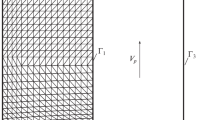Abstract
Dislocation structures of interfaces between bonded (001) Si wafers with co-existing low-angle twist and tilt misorientations were studied by transmission electron microscopy. At dominating twist, a square screw dislocation network accommodates the twist, and interacts with steps at the interface, forming 60-degree dislocations. As the step density, i.e., the tilt angle, increases relative to the twist angle, the density of so-called zigzag reactions increases. Finally, hexagonal dislocation meshes dominate the dislocation configuration. It was found that the plan-view observations give the crystallographic relations accurately. The structures of the dislocation configurations were analyzed using Bollmann's dualistic representation. The rotation axes and angles were determined.
Similar content being viewed by others
References
H. FÖll and D. Ast, Phil. Mag. A 40 (1979) 589.
C. B. Carter, H. FÖll, D. Ast and S. L. Sass, ibid. A 43 (1981) 441.
G. C. Perreault, S. L. Hyland and D. G. Ast, ibid. A 64 (1991) 64.
R. Gafiteanu, S. Chevacharoenkul, U. M. GÖsele and T. Y. Tan, in “Microscopy of Semiconducting Materials 1993,” Inst. Phys. Conf. Ser. No. 134, edited by A. Cullis, A. E. Staton-Bevan and J. L. Hutchinson (Inst. Phys. Publ., Bristol. 1993) p. 87.
M. Benamara, A. Rocher, A. Laporte, G. Sarrabayrouse, L. Lescouzeres, A. Peyrelavigne, M. Fnaiech and A. Claverie, Mater. Res. Soc. Symp. Proc. 378 (1995) 863.
A. PlÖssl, R. Scholz and T. Akatsu, in “Semiconductor Wafer Bonding: Science, Technology, and Applications V,” Electrochemical Society Proceedings, Vol. 99–35, edited by C. E. Hunt, H. Baumgart, U. Gösele and T. Abe (Pennington, New Jersey, The Electrochem. Soc., 2001) p. 232.
R. Scholz, L. F. Gilles, S. Hopfe, A. PlÖssl and U. GÖsele, in “Microscopy of Semiconducting Materials 1999,” Inst. Phys. Conf. Ser. No. 164, edited by A. Cullis and R. Beanland (Inst. Phys. Publ., Bristol, 1999) p. 439.
C. Chen, K. N. Tu, C. H. Tung, T. T. Sheng, A. PlÖssl, R. Scholz and U. GÖsele, Phil. Mag. A 80 (2000) 881.
W. Bollmann, ibid. A 7 (1962) 1513.
S. Amelinckx and W. Dekeyser, in “Solid State Physics,” Vol. 8, edited by F. Seitz and D. Turnbull (Academic Press, New York, 1959) p. 325.
T. Schober and R. W. Balluffi, Phil. Mag. 24 (1971) 165.
P. Sutton and R. W. Balluffi, in “Interfaces in Crystalline Materials” (Clarendon Press, Oxford, 1995) p. 23.
Author information
Authors and Affiliations
Rights and permissions
About this article
Cite this article
Akatsu, T., Scholz, R. & Gösele, U. Dislocation structure in low-angle interfaces between bonded Si(001) wafers. Journal of Materials Science 39, 3031–3039 (2004). https://doi.org/10.1023/B:JMSC.0000025829.40338.04
Issue Date:
DOI: https://doi.org/10.1023/B:JMSC.0000025829.40338.04



